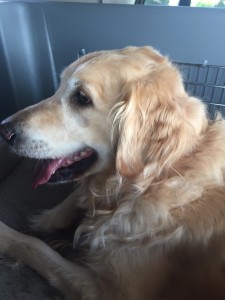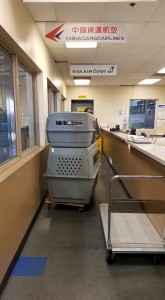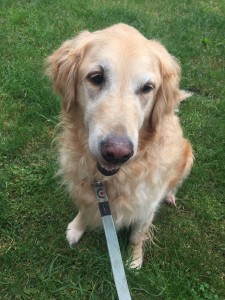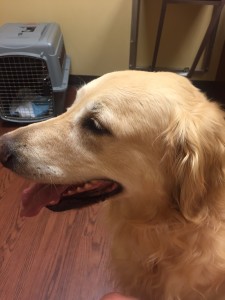
Moving can be stressful. Moving to another country can be very stressful. Moving to another country with a large dog and two cats in tow can be incredibly stressful! Getting ready for the big move to England was an adventure, and this part of the story focuses on getting my dog (Devon, golden retriever), two cats (Newton, white and brown tabby cat and Halley, tuxedo cat), and myself to England.
There are really only two options for getting to England: fly or sail. There is a ship (the Queen Mary II) that has kennels for animals while making the crossing. We considered this option, but you had to book at least a year in advance, and we just weren’t in a position to plan that far ahead. So, flying it was going to be!
But before we can book flights and even think about all of the travel arrangements, the animals need the correct paperwork, inoculations, and microchips to gain entry into England! The entire process from meeting the entry requirements to booking flights and actually traveling was a multi-step process that took several months.
- Make sure all animals have an international standard microchip that scans properly. Devon’s had been placed by the vet, and his met the standard. The cats were adopted from a shelter, and their microchips were the US standard not the international one, so the cats each had to have a new microchip implanted.
- Make sure everyone has an up to date rabies shot. This must happen at least 30 days before they fly. Since our cats were indoor cats, they hadn’t had one since we adopted them, and Devon was overdue for his, so this was next on the list. Items 1 and 2 were taken care of at the end of March.
- Determine airline to use for transporting the pets. I wanted to be on the same flight as Devon, Halley, and Newton, so that limited my options flying out of Atlanta to British Airways. Thankfully, they had lots of great reviews for flying pets as air cargo.
-

Newton tests out Devon’s crate Measure pets to determine what size crate each one would need. It was easy for the cats as the IATA laws require cats to travel in medium sized crates even though they could get by with much smaller ones. However, this meant no need to attempt measuring the height and length of two cats! The Devon did need to be measured from floor to top of head, nose to tail, and floor to top of his legs. This was a little tricky, but not too bad. This information was used to select his crate size. The requirements are that the dog can stand up without hitting the top of the crate and turn around in the crate. Devon is a pretty large golden retriever, and he was just a little too tall to fit in a size smaller crate, so he would need the largest dog crate available.
- Determine cost of flying pets and the booking processes. When flying a pet as cargo internationally, the fare charged is based on the volume the crate takes up and the weight. That’s why we had to determine the crate each pet needed first. I emailed the cargo division to get quotes. (It costs a lot of money to fly pets, but Devon was the most expensive!) Eventually I called to book their flights, but found out they don’t know if they will have room until two weeks before departure! So, that means waiting until you have a better idea of when you’ll be leaving!
- Wait for your visa to live in England to arrive. This took a couple of weeks longer than I was expecting, but I finally got word my visa was approved the day after Memorial Day.
- Arrange flights – called the airline cargo division, and was able to book the pets on the flight I was hoping to take in June. Believe or not, you don’t pay for the flight then. You pay for the flights when you drop them off, so they can weigh and measure in person before calculating your final total.
- Book your own flight. That was probably the easiest part of the entire process.
- Purchase crates (one each), crate mats, food and water containers, and approved crate screws for the flight. Thank you Amazon!
- Book vet appointments for health checks and paperwork filling out.
- Got to vet appointments and have USDA and EU paperwork completed. This wasn’t too difficult except that I decided I could take all three of them to the vet by myself at the same time. Somehow, I managed!
- Book an appointment to go to the USDA office in Georgia to have paperwork checked and signed off. I booked this for the day before our flights as it was the only available slot.
- Email paperwork to the USDA office to check to make sure there are no errors before you get there. I did this and received a reply that everything was okay.
- Take Devon back to the vet for a tapeworm treatment that has to be given within 72 hours of the flight.
- Do a dry run to see how you will fit three crates, three animals, three adults, two suitcases, and two carry on pieces of luggage your dad’s car.
- Make sure your husband rents a vehicle large enough to fit the dog, cats, and crates for when he picks you up from the airport.
- Go the USDA office to have your paperwork checked and signed off on. Wait forever as they were short staffed that week. Freak out when they tell you there is a problem with your paperwork. Panic and assume you’ll miss your flight the next day since you don’t want to fly without the pets. Calm down when they tell you it can be fixed without driving an hour and half back to the vet’s office. Call the vets to fax over the needed information. Wait some more. Finally get paperwork signed off on. (Did I mention my parents had to drive me as by this point one of our cars had already been picked up to be taken to Savannah’s port in preparation for shipping to England, and I had sold our other two cars?)
- Finish packing and clearing out your house. Don’t forget to pack food for the dog and cats so they’ll have something familiar to eat for the first few days in a new country and some favorite toys.
-

On the way to the airport Pack up the car. We figured out that Devon’s crate would not fit in the car with everything else assembled, so we left it unassembled with top sitting in the bottom. Convince Devon that he can jump up into the SUV even though he’s only ever ridden in a car before. Fail at convincing. Try lifting an 82 pound dog into the car, and don’t get too far. Finally convince Devon he can do it with a huge push of help from my parents and me ready to sit with him in the car. Loading everything else wasn’t too bad, but it was one packed car!
- Drive to the airport in order to drop off the animals to the air cargo hanger at least five hours before our scheduled departure time.
- Arrive at the cargo area and assemble Devon’s crate.
- Go into cargo area and show paperwork to the agents. Have them look through your paperwork and find a sheet that the USDA office didn’t date (even though they were checking everything), and be told by the agents that if you fly, your animals may be refused entry when you get to England or be quarantined and fined. Start to freak out. Try to verify by having them contact the Animal Reception Centre in London. The agent told me I could speak with them, so I did. Since the paper without the date was a USDA one that was not needed for entry and the EU papers were complete, find out there won’t be a problem on arrival.
-

Waiving goodbye in Atlanta Bring the Devon, his crate, and the crated cats into the building for check in. Devon had to stand in front of his crate for a photo for the records. Get everyone weighed and checked in. Get Devon into his crate. (I thought this would be one of the most difficult steps, but he just hopped right in!) Then, watch them wheel away your precious cargo, and hope and pray they get on the plane and you reunite safely in London.
- Head to the passenger terminal and check in to your flight. Spend as much time with your parents as you can. Finally, head through security. Be waived to the side in security to have your bag opened and checked because something set it off. Be asked why you are traveling with dog and cat food, and then explain they are flying as cargo. The TSA agent was very nice, and wished me luck on the flight.
- Wait for board of your flight at the gate, and board at the allotted time. Find your seat in the plane and settle in for a long flight.
- Realize that you all have been sitting on the plane for a while, but it seems like there is something causing a delay. Hear pilot come over the intercom indicating that they are having trouble closing the cargo doors, and that is the hold up.
- Wait even longer. Worry about what is going on. Have the pilot come over the intercom again explaining that the hold up is due to the fact that a dog and two cats are traveling in the cargo hold today. As the animals are loaded last, some luggage had to be rearranged because suitcases were against the dog’s crate, and that is not allowed. Feel relieved that you know your dog and cats are on the flight, and apologize to your seat mate as you have inadvertently caused a flight delay.
- Prepare for take off, and get ready for the eight hour flight.
- Eight hours later, arrive in London. Disembark, go through immigration, baggage claim, and customs. Reunite with your husband.
-

Animal Reception Centre at London Heathrow Head to the Animal Reception Centre. Find out that they have arrived and are doing well. Feel relieved while waiting for the paperwork to be checked.
- Find out there is a problem with your paperwork (!) even after being checked by the vet, the USDA office, and the airline. The good news is that it can be fixed by talking to the vet, but because of the five hour time difference, the vet’s office doesn’t open for five hours, and they tell you you’ll need to wait unless you can get in touch with the vet sooner. Call the emergency vet’s office to see if they can get in touch with your vet. Have the vet text you back very quickly and give the ARC agents a number to phone. Get the missing information validated, and wait for the rest of the paperwork process.
-

This is what a jet lagged dog looks like Finally reunite with your dog and cats! The cats were super anxious, and Devon looked jet lagged, but everyone survived the journey!
- Load up the car which involves disassembling Devon’s crate, putting both cats in the same crate, and disassembling the other one in order to get everything to fit in the car.
- Head to our new home.
- Unload, relax, and start getting to know our new home.
When I was researching the process for getting pets into England, I found that there are agencies that will rent crates, take care of all of the paperwork, and help with the entire process. I thought I could handle doing it all on my own. Obviously, I did, but not without quite a bit of hassle and many very stressful moments and near panic attacks. In retrospect, it probably wouldn’t have cost that much more to use one of these companies, and if you’re contemplating a transoceanic move, you might want to consider them as an option.
The good news is that Devon, Halley, and Newton settled into their new lives here really quickly. The climate agrees with them all very much, and all three of them are super happy and content. I didn’t mention it before, but between the time I had the initial microchips and rabies shots done in March and leaving in June, Newton got really sick. He stopped eating, lost a lot of weight, and ended up with hepatic lipidosis (fatty liver disease). After spending way too much money on trying to get him better, I told him he could either give up, or start eating again (the “cure” for this disease), and come with the rest of us to England. Well, he obviously chose England, and you would never know now how close he was to dying. He loves his freedom here in England as he gets to roam outside, explore, and even catch mice! He loves living in England!
I hope you enjoyed this (very long) story of our moving adventure to England. I want to let you know that I never would have been able to do this without the helps of my parents. They were a lifesaver many times! So, don’t think you can make a big move like this without a lot of help! Look for Friday’s post all about the differences between finding a teaching job in the US and finding a teaching job in the UK.

I’ve really enjoyed this Janelle – can’t wait for the net installment.
Thank you!